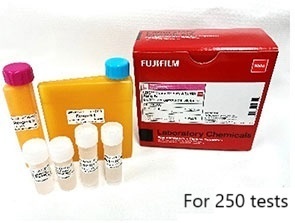Albumin Assay Kits
Albumin is a hydrophilic protein mostly present in cells and body fluids and plasma albumin occupies approximately 56% - 60% of total plasma proteins. Plasma albumin is synthesized in the liver cells, plays an important role in maintaining blood osmotic pressure, and contributes the transfer of hydrophobic substances. Concentration of albumin in plasma is lowered in liver cirrhosis due to decreased biosynthesis, in malnutrition and pyrexial diseases due to increased consumption of albumin, and in renal damage due to secretion into urine. Meanwhile urinary albumin is increased since excretion of albumin into urine increased in glomerulonephritis, nephritic syndrome, and diabetic nephropathy.
Serum, plasma, and urinary albumin measurements are commonly performed using the turbidimetric immunoassay (TIA) method. Fujifilm Wako offers TIA reagents optimized for automated analyzers compatible with specimens from rats, mice, and monkeys. For applications requiring higher sensitivity, ELISA is recommended. Fujifilm Wako's ELISA kits support a wide range of research needs, such as investigating the association between blood or urinary albumin levels and specific diseases, studying albumin biosynthesis in vitro, detecting contamination of fetal bovine serum (FBS/FCS) in biologically active substances derived from cell cultures, and monitoring albumin production as an indicator of success in liver cell or tissue transplantation in Nagase analbuminemic rats (NAR).
What is Albumin?
Albumin is a hydrophilic simple protein mostly present in cells and body fluids. Plasma albumin (M.W. 69,000, pl 4.9) occupies approximately 56% - 60% of total plasma proteins. Plasma albumin is synthesized in the liver cells, plays an important role in maintaining blood osmotic pressure, and contributes the transfer of hydrophobic substances e.g. fatty acids, bilirubin, and thyroxine by binding them. Concentration of albumin in plasma is lowered in liver cirrhosis due to decreased biosynthesis, in malnutrition and pyrexial diseases due to increased consumption of albumin, and in renal damage due to secretion into urine.
In normal healthy subjects, excretion of plasma albumin into urine is very little (approx. 30 mg/day), but concentration of urinary albumin is increased in glomerulonephritis, nephritic syndrome, and diabetic nephropathy since albumin excretion into the urine is increased in renal diseases. It also sometimes increases in pyrexia, hypertension, congestive heart failure (CHF), and urinary tract infection (UTI). A transient increase of urinary albumin concentration is observed after hard exercise, physical work, high-temperature bath, mental excitement, stress, intake of much protein, and before menstruation even in healthy subjects and these are called physiological/functional/exercise proteinuria (albuminuria). Orthostatic proteinuria is sometimes observed in teenagers as well.
In humans, a rare congenital disorder called hypoalbuminemia, sometimes referred to as analbuminemia, is characterized by the presence of only very small amounts of albumin. Clinical symptoms include mild edema and moderate hypotension, with no evidence of liver dysfunction or proteinuria. Rat models for analbuminemia have been developed. A model analbuminemia rat has been established by Dr. Sumi Nagase in Sasaki Institute (Japan) which has been derived from Sprague-Dawley strain and is called Nagase analbuminemia rat (NAR).
Serum, plasma, and urinary albumin measurements are commonly performed using TIA method. Fujifilm Wako offers TIA reagents optimized for automated analyzers compatible with specimens from rats, mice, and monkeys. For applications requiring higher sensitivity, ELISA is recommended. Fujifilm Wako’s ELISA kits support a wide range of research needs, such as investigating the association between blood or urinary albumin levels and specific diseases, studying albumin biosynthesis in vitro, detecting contamination of FBS/FCS in biologically active substances derived from cell cultures, and monitoring albumin production as an indicator of success in liver cell or tissue transplantation in NAR.
Product Lineup
Turbidimetric Immuno Assay Kits (TIA Kits for automated analyzers)
Features
- Rapid measurement (10 minutes)
- Wide measurement range with excellent reproducibility
- Compatible with general-purpose automated biochemical analyzers
For details on analysis parameters, please contact us.
| Appearance |  |
 |
|---|---|---|
| Product Name | LBIS™ Mouse Urinary Albumin Assay Kit | LBIS™ Rat Urinary Albumin Assay Kit |
| Product No. (Package Size) |
295-92701 (60 tests) | 297-92901 (60 tests) |
| 291-92703 (250 tests) | 293-92903 (250 tests) | |
| Calibration curve range | 6.17-500 μg/mL | 6.17-500 μg/mL |
| Analysis sample | Mouse serum/urine | Rat serum/urine |
| Sample volume | 6 μL | 6 μL |
ELISA Kits
Features
- Enables rapid measurement
- Requires only a small sample volume
- Provides high measurement accuracy and excellent reproducibility
- Uses environmentally friendly preservatives
- Supplied as ready-to-use liquid reagents
| Product Name | LBIS™ Mouse Albumin ELISA Kit | LBIS™ Rat Albumin ELISA Kit | LBIS™ Bovine Albumin ELISA Kit |
|---|---|---|---|
| Product No. (Package Size) |
291-92301 (96 tests) | 293-92501 (96 tests) | 295-92201 (96 tests) |
| 297-92303 (96 tests x2) | 299-92503 (96 tests x2) | ||
| Calibration curve range | 50-1,000 ng/mL | 50-1,000 ng/mL | 0.78-50 ng/mL |
| Analysis sample | Mouse serum/plasma (heparin recommended)/urine | Rat serum/plasma (heparin recommended)/urine | Cell culture, bovine serum*/plasma* |
| Sample volume | 5 μL | 5 μL | 100 μL |
Product List
- Open All
- Close All
TIA Kits (for automatic analyzers)
ELISA Kits
Control Serum
For research use or further manufacturing use only. Not for use in diagnostic procedures.
Product content may differ from the actual image due to minor specification changes etc.
If the revision of product standards and packaging standards has been made, there is a case where the actual product specifications and images are different.



